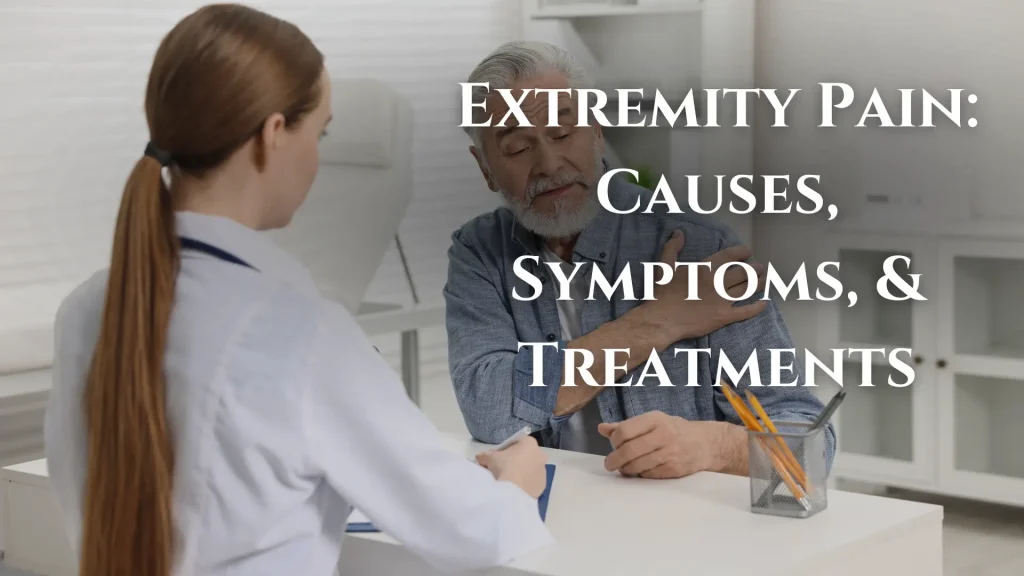
If you’ve experienced pain anywhere below your head and torso, you’ve experienced what’s known as extremity pain. While this pain is one of the common causes of extremity pain, it may also indicate a more significant medical issue. So, what causes extremity pain, what are the symptoms, and what treatments are available for your extremity pain? Identifying the causes of pain in the extremities is key to finding effective treatment options and enhancing your overall quality of life.
Causes of Extremity Pain
There are two types of extremities: upper extremities (referring to the arms and upper torso) and lower extremities (referring to the legs and lower torso). In both cases, extremity pain can be debilitating and interfere with quality of life.
The root cause of most extremity pain is stress. “Stress” is a term often used to describe mental and emotional debilitation, but in medical review terms, “stress” refers to anything that inflicts trauma upon the parts of your body.
Specific causes of extremity pain include:
- Poor posture. Remember when your grandmother told you to “stand up straight”? She wasn’t just admonishing you but preparing you for a lifetime of good health conditions. Over time, poor posture can result in various disorders, including extremity pain.
- Infection. Some bacterial and viral infections target the extremities, causing pain with each movement.
- Bone fractures. Bone fractures – even the smallest ones – can cause pain in the extremities long after they’ve healed, especially if they haven’t healed properly.
- A sedentary lifestyle. If you’re not an active person – and most Americans aren’t today – suddenly adopting an active lifestyle will cause extreme pain.
Symptoms of Extremity Pain
The symptoms of extremity pain are immediately evident, and the intensity can range from a dull, throbbing pain to an extreme, burning, localized pain. Regardless of the intensity of the pain, it can compromise day-to-day life. They include:
- Discoloration. When your extremities take on a bluish or purplish tone, this indicates poor circulation. Over time, poor circulation can cause extremity pain and, if left untreated, permanently damage the extremities.
- Redness or warmth in the affected area. When your extremities are red and warm, it can indicate an infection. Over time, an untreated infection will cause extremity pain.
- General illness. Another sign of infection is a general feeling of illness, including symptoms like a fever and chills. A more severe infection can trigger extremity pain.
- Wounds that are Slow to Heal. Severe wounds take time to heal correctly, but minor injuries (such as a cut or a scrape) shouldn’t take more than a few days to recover. Slow-healing wounds are usually the first sign of diabetes, which can cause extremity pain if left untreated.
Please read more about how to manage pain: Managing Pain While Working from Home
Treatments Available for Extremity Pain
 Countless therapies are available for extremity pain, and treatments depend on the severity and source of the pain. Not all treatments will be effective for all pain, and it is important to consult a doctor before adopting a regimen. Available treatments include:
Countless therapies are available for extremity pain, and treatments depend on the severity and source of the pain. Not all treatments will be effective for all pain, and it is important to consult a doctor before adopting a regimen. Available treatments include:
- Bursa injections. When extremity pain is caused by compromised bursa sacs (the fluid-filled sacs between the joints), injections can refill those sacs and reduce pain.
- Steroids. When the epidural space (a layer filled with lymphatics, fat, and blood vessels located between the spinal cord and the spinal canal) becomes inflamed, it causes extremity pain. In cases like these, steroidal injections are the only way for the sufferer to find relief.
- Physical therapy. This treatment is often recommended for extremity pain caused by physical exertion or strain. Many people wonder, Is physical therapy painful? While some discomfort may occur during recovery, therapy is carefully guided to ensure it’s safe and beneficial for long-term healing.
- Medication. A patient will have medications prescribed if the pain in the extremities is so severe that only a regimen with painkillers is effective in treating it. However, these medications will only be administered under the strict care and observation of a physician at AllCare Health & Pain, as such prescriptions can easily lead to abuse and addictions if not managed correctly.
- Radiofrequency neurotomy. Sometimes known as ablation, radiofrequency neurotomy is a minor surgery in which heat destroys tissue. By cutting off the so-called “pain pathway,” patients who suffer from chronic pain can experience some relief from their symptoms.
- Peripheral nerve stimulation. known by its abbreviation PNS, uses electricity to cut off the so-called “pain pathway.” While neurotomy targets the spinal nerves, PNS targets the nerve experiencing pain and nerve damage.
Are You Experiencing Extreme Pain? Let AllCare Health & Pain Find You Relief
Life would be much better if you didn’t have to live in pain, and that’s why the doctors at AllCare Health & Pain are here to help. Our team is a world-class pain management center servicing patients in Jersey City and the surrounding areas. We have helped hundreds of clients find pain relief from extremity pain. Contact us online or call us today at 201-386-9800, and let us take care of the pain in your extremities.

